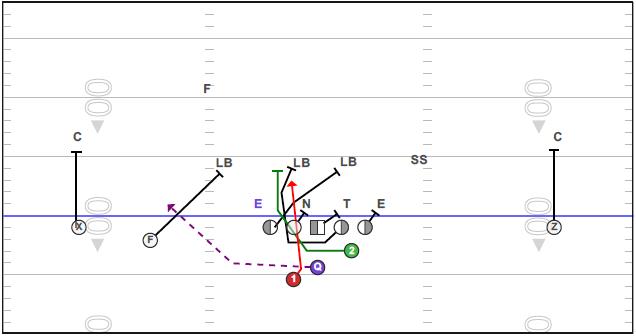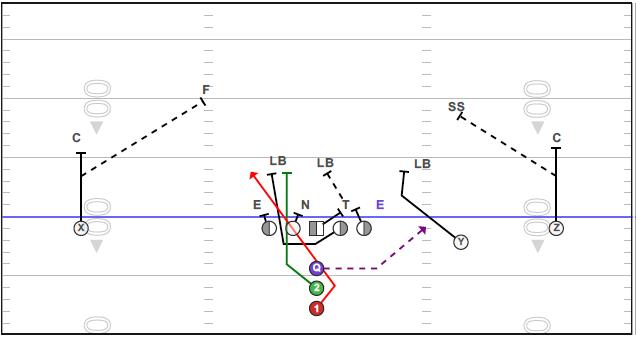Previously
Part I - The Power Series Origins
Part II - Off Tackle Power Earns the Name Power
Retaining the Power Series
While "Power" began to be defined as the Off-Tackle Power O variant in the 1980s, most offenses, including the split back dominated West Coast Offenses, retained much of the Power Series plays within their playbook, albeit under different names. This made use of multiple backs to alter the backfield flow, changing the kick blocker, lead blockers, or sending someone elsewhere altogether.
The Way Forward for Power Sweep
18/19 BOB (Big-on-Big, Back-on-Backer) is the classic Power Sweep
 |
| 1982 San Francisco 49ers Playbook |
 |
| 1975 Delaware Wing T Playbook |
And would remain a fixture as the Wing T was adapted for the modern game.
 |
| 2010 Auburn Offensive Playbook |
As off-tackle Power became more of a base play, teams also started incorporating a "Bounce" version of standard Power to get outside on teams that started to try to condense on the kick block.
 |
| 1995 Florida Offensive Playbook |
While this is likely a standard Power O call, the defensive EMOL along with the standard pull and depth naturally allow this play to bounce outside.
Bluff and the Origins of Modern Counter
16/17 A Bluff is an iteration off this Power Sweep, with the FB faking the block on the backer and the PSG kicking him, in a Down Scheme type play. But importantly, it retains the kick block, and the wrap block.
 |
| 1982 San Francisco 49ers Playbook |
This looks similar to the way some teams currently run Down G with a backside pull. Here it is with a Center pull instead of a BSG
The intention today is not to cover the Counter OT and Counter OF/OH of the world, but it is nearly impossible, because:
 |
| 1989 Alabama Offensive Playbook |
Right, they are cousins. By the 1990s, most playbooks included both, but that wasn't originally the case. Many option teams (and the utilization of zone blocking had come about by now for many of those teams) rarely pulled OL. But they still did incorporate trap blocking as a changeup. Thus, your off-tackle Power in those systems now largely relied on a kick block from a BSG and a lead from a FB (or in this case, no lead)
 |
| 1968 Houston Veer Playbook |
Counter until that time had largely been based on misdirection within the backfield, including with a play fake. This cousin of Power largely changed that. Counter OT started like most counters of the day, with backfield misdirection and a playfake.
This could be a fake to the FB and a sweep to the Tailback (or Wing coming back the other way)
 |
| 1983 Nebraska Offensive Playbook |
Or could be a fake to the Tailback and a counter with the FB, holdovers from the split back era with a modern off tackle Power O setup
 |
| 1985 UConn Offensive Playbook |
In the mid-80s, the zone revolution came about, and teams like the Joe Gibbs Washington football team. This allowed the use of FBs, but also 12 personnel with wings to seal the backside.
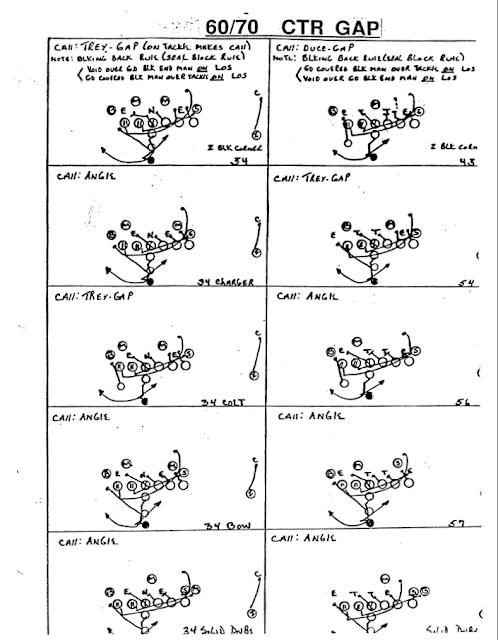 |
| 1992 Washington Redskins Playbook |
And while the backside began to prove difficult to block, Counter OF came about, utilizing the same two plays to kick and wrap as Power, but inverting their responsibilities.
 |
| 1994 Penn State Offensive Playbook |
A Gap Power
The other item that zone/option teams were used to is Fold blocks as an interior changeup to their base schemes. This resulted in an A-Gap Variation of Power existing in many playbooks.
90/91 O Is a form of A-Gap Power, with the playside OL kicking out the defense and the BSG wrapping to the MIKE.
 |
| 1982 San Francisco 49ers Playbook |
Also seen within Nebraska's Option playbook of the era
 |
| 1983 Nebraska Offensive Playbook |
This received new life when North Dakota State began heavily utilizing A-Gap Power
NDSU’s bread and butter - A Gap Power. Look at the discipline by the left guard to stay square through his pull. pic.twitter.com/bUgGtqOhHx
— Brad Kelly (@BradKelly17) January 11, 2020
Alright there LG/LT 😳 Sheesh pic.twitter.com/xlwdLPt6kW
— Ben Fennell (@BenFennell_NFL) January 19, 2021
Dealing with a 6-Technique
A head-up defender on the TE has historically caused a lot of issues for Power. Too tight to kick, not far enough inside to get a good combo and drive inside. Arcing the TE is a key way of messing with the TE. The arc often causes the 6-technique to naturally widen, as if getting into a pass rush or protecting the reach block.
14/15 HB O is a Y-arc variant of Power O, which became a common way of blocking a 6-technique defender. The arc block generally widening the player for the kick, and allowing the TE to handle the overhang.
 |
| 1997 Buffalo Bills Offensive Playbook |
 |
| 1982 San Francisco 49ers Playbook |
16/17 BIM (as seen above, but this time with a Y-arc) has s potential double-team on the C-gap defender with the PST and FB, with the Y-arcing outside the play and the PSLB getting logged by the puller.
 |
| 1982 San Francisco 49ers Playbook |
Misdirection Maintained
Lag O is a form of A gap, single back Power with split flow in the backfield, which is an early form of Dart. Mostly throughout the 80s and 90s, teams retained various forms of split flow to prevent defenses from being able to identify the direction of the run immediately at the snap.
 |
| 1983 San Francisco 49ers Offensive Playbook |
 |
| 1998 Wisconsin Playbook |
Single Back Power
While the answer seems obvious now, given all the Power Solid and Split flow versions of power you see above, early spread teams largely struggled with figuring out how to block Power within their framework. Some went straight to the modern answer. |
| 1998 Washington Huskies Offensive Playbook |
 |
| 1999 Oklahoma Offensive Playbook |
3rd & 8 with a chance to force a FG attempt. Someone has to make a play.
— Due# (@JDue51) October 20, 2019
The QB does. pic.twitter.com/q7rjxLiycR
Another favorite of the time was Dart
 |
| 2000 Northwestern Offensive Playbook |
Mizzou running Dart vs. the Double 4i Front
— Coach Dan Casey (@CoachDanCasey) July 21, 2018
- H roots out Overhang Defender
- LT blocks down on 4i
- LG & C double Nose, climb to Will
- RG blocks back on backside 4i
- RT wraps for Mike
QB holds backside Overhang Defender with RPO fake pic.twitter.com/vBzVnvt4g7
 |
| 2002 Kansas State Offensive Playbook |
 |
| 2004 New England Patriots Offensive Playbook |
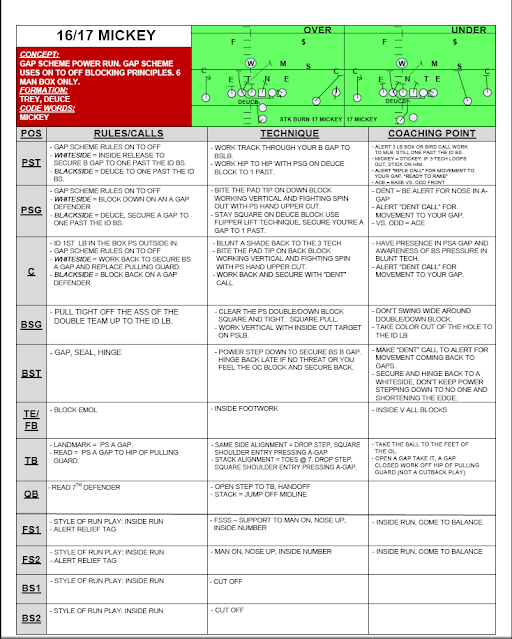 |
| 2014 Ohio State Playbook |
 |
| 2014 Ohio State Offensive Playbook |
 |
| 1992 Raiders Offensive Playbook |
Bo Jackson running power for a TD out of 22P split backs. Good cut block by Marcus Allen on the frontside end.
— Old Football Film (@FilmHistoric) April 16, 2021
🎥 @Ol_TimeFootball
pic.twitter.com/REdJeUs7qS
The use of multiple TEs or motion WRs also allowed to add blockers to the play
 |
| 2014 San Francisco Offensive Playbook |
I've written two articles on Wisconsin utilizing just this (Link 1, Link 2).
In a more modern sense, this has involved the Q Run game, utilizing the RB as an additional blocker.
 |
| 2014 San Francisco 49ers Offensive Playbook |
Teams have also learned to utilize WRs or TEs on the Shovel pass to make use of Power blocking.
 |
| 2004 Utah Offensive Playbook |
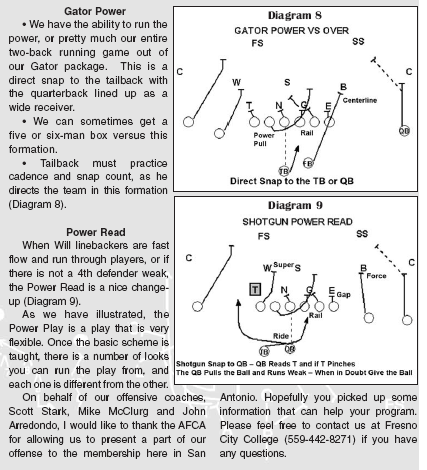 |
| 2007 AFCA "The Power Play" |
 |
| 2014 Ohio State Playbook |
 |
| 2014 Ohio State Offensive Playbook |
 |
| 2019 Penn State Offense |
Penn State running dart read with McSorley AND Barkley was absolutely vicious. Either could have popped for big yards pic.twitter.com/pumIZpXz4b
— Tony Shiffman (@CoachShiffman) January 4, 2019
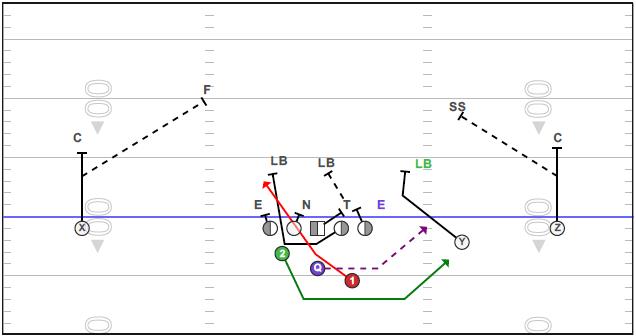 |
| USA Football For More |
 |
| Visit link for video |
Saban talking about how lead/gap scheme RPO's do a better job displacing second level defenders to open throwing windows than zone concepts making them harder to defend, which makes sense considering his defense saw it every day in practice pic.twitter.com/ScourJNl3d
— Fit Harrington (@futbolguysguy) April 5, 2021
Power read again, this time give to the jet with 3 arc/lead blockers. MSU 2nd level does great to leverage blocks, squeeze the hole, and flow at LB level to limit to 3 yards, but it starts with the CB and overhang pic.twitter.com/DigfD7CtE0
— Space Coyote (@SpaceCoyoteBDS) December 3, 2020
Power with the C and Y trading responsibilities. C kicks the 5, and Y is up to the PSLB.
— All-22 Film Breakdown (@All22_Breakdown) December 21, 2020
Malzahn used to call this counter back in his HS days pic.twitter.com/VNAaMnApCQ
Pulling the Center rather than the BSG based on defensive formation
Mississippi State shows two great answers to LSU’s 4i Alignment with an Overhang LB to the Strong Side.
— Coach Dan Casey (@CoachDanCasey) March 30, 2018
1️⃣ QB Power [pull the C, lead with RB]
2️⃣ Tackle Wrap Counter
In this defensive alignment, it is imperative for the edge defender to keep contain! pic.twitter.com/1GQj6OfnjB
Power has withstood the test of time. It has lived on in various iterations but has remained a part of football for nearly 100 years. It is versatile, adaptable, and dependable. It is, indeed, "God's Play"
And here's a backside cut against the pull, with Power Scissors
Etc.
Smart Football - Evolution of Inverted Veer
Smart Football - Explanation and Cut-Ups of the Power O
Grantland - Why Power Running Works
Football Study Hall - The Modern Power Run
Inside the Pylon - Three Power Run Schemes
Concerning Sports - Baylor's History with the Power Run Game
The Spread Offense - How to Run Single Back Power
Run The Power - Why Weak Power is Great






